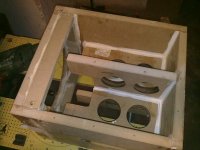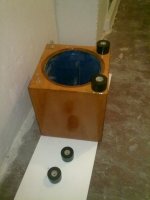Hello,
I am tring to make a 2.1 system, and i was thinking of an passive crossover for the speakers and an active crossover for subwoofer.
Can i just put 1 cap (1st order) in serie with the main speakers, or is it better to make the coils for the (2nd order).
The coil, can it be done with 24 awg wire?
Waht is the influence of the DC resistence of the coil in the filter?
Sorry for the few questions,
R
I am tring to make a 2.1 system, and i was thinking of an passive crossover for the speakers and an active crossover for subwoofer.
Can i just put 1 cap (1st order) in serie with the main speakers, or is it better to make the coils for the (2nd order).
The coil, can it be done with 24 awg wire?
Waht is the influence of the DC resistence of the coil in the filter?
Sorry for the few questions,
R
It's good to know the main drivers.
It can be decided later, depending of the design/prototype, what is better a 1/2.order.
If you need any help, please ask.😀
There are other times that you need a resistor for padding that is like adding more resistance (in series).
It can be decided later, depending of the design/prototype, what is better a 1/2.order.
If you need any help, please ask.😀
Sometimes is better to have low DCR for a better freq. output and LF (low frequency) output.Waht is the influence of the DC resistence of the coil in the filter?
There are other times that you need a resistor for padding that is like adding more resistance (in series).
Last edited:
A major concern should be the impedance of the mains over frequency. If un-compensated the resonant peak(s) due to the box (and port) could give you significantly different response than you expect. For an example, see Zaph's B3S article. Notice the high value components required to flatten the impedance.
You'll also need large value caps (and inductors if you go higher order.) You want to match the acoustic slopes of your main rolloff including crossover to that of the sub's low pass. Shallow roll off on the sub makes it easier to localize. Not much of an issue if it is centered between the mains, but otherwise, I suggest no less than 2nd order up to 60 Hz, or if you want to go higher, go 4th order.
Since you're making an active crossover for the sub, why not make both low pass and high pass active?
You'll also need large value caps (and inductors if you go higher order.) You want to match the acoustic slopes of your main rolloff including crossover to that of the sub's low pass. Shallow roll off on the sub makes it easier to localize. Not much of an issue if it is centered between the mains, but otherwise, I suggest no less than 2nd order up to 60 Hz, or if you want to go higher, go 4th order.
Since you're making an active crossover for the sub, why not make both low pass and high pass active?
A 1st pass solution is to put the satelittes in an appropriately sized sealed box and use its natural 2nd order HP as the filter. Then if you need morw add a cap at the amplifier input.
dave
dave
The main speakers that i have are - Totem arro - and i want to take off the bass/subbass from them.
internet site
"Looking at the impedance/phase measurements, we see well controlled values that bottom in the mid bass at 4 ohms and rise to 22 ohms just below in frequency. "
"Since you're making an active crossover for the sub, why not make both low pass and high pass active? "
I am afraid to mess up the signal with the OP-AMP.
I tried the cap. and it worked, but can it be better ??
ahhhhhhhh.... the subwoofer is an peerless XLS10 (830452) in a sealed box.
best regards,
R
internet site
"Looking at the impedance/phase measurements, we see well controlled values that bottom in the mid bass at 4 ohms and rise to 22 ohms just below in frequency. "
An externally hosted image should be here but it was not working when we last tested it.
"Since you're making an active crossover for the sub, why not make both low pass and high pass active? "
I am afraid to mess up the signal with the OP-AMP.
I tried the cap. and it worked, but can it be better ??
ahhhhhhhh.... the subwoofer is an peerless XLS10 (830452) in a sealed box.
best regards,
R
What cap do you have? I would point to a xover at about 150Hz (or other 100Hz?). The best thing should be a in-line xover so to not affect the main speakers/xover frequency.I tried the cap. and it worked, but can it be better ??
FMOD Crossover Pair 150 Hz High Pass | Parts-Express.com
And maybe closing/adjusting the back outputs/vents/transmission, after you have the Sub working.😎
Last edited:
If you like the way it sounds, stick with it.
However, if you measure the response with the cap, you'll see that it doesn't roll off the way that you think. The idea of the cap is to have a voltage divider so that the cap's impedance is equal to the speakers' at say 80 Hz. If you sized the cap based on 8 ohms nominal impedance, the formula gives you 8 ohms impedance while your speaker has an impedance of nearly 20 ohms, so you won't get as much attenuation as you thought. Same at the port tuning frequency around 37 Hz. You'll have more attenuation than planned at 50 Hz and 150 Hz as your main impedance dips.
It's not as simple as just looking at the impedance magnitude, you need to the phase of the impedance in your calculations, but you get the idea.
If you don't like op amps, you can make a crossover with a jfet, bipolar or mosfet buffer or even a tube, as well as go completely passive, but passive requires more drive and you must incorporate the amplifier's input impedance in your calculations.
Personally, I don't find anything wrong with opamps (I use a lot of OPA2134), but of course you may not like them. Linkwitz' Orions use a load of OPA2134a in the crossover and get rave reviews. There are other opamp choices that some find better, I haven't tried any of the real high speed amps.
However, if you measure the response with the cap, you'll see that it doesn't roll off the way that you think. The idea of the cap is to have a voltage divider so that the cap's impedance is equal to the speakers' at say 80 Hz. If you sized the cap based on 8 ohms nominal impedance, the formula gives you 8 ohms impedance while your speaker has an impedance of nearly 20 ohms, so you won't get as much attenuation as you thought. Same at the port tuning frequency around 37 Hz. You'll have more attenuation than planned at 50 Hz and 150 Hz as your main impedance dips.
It's not as simple as just looking at the impedance magnitude, you need to the phase of the impedance in your calculations, but you get the idea.
If you don't like op amps, you can make a crossover with a jfet, bipolar or mosfet buffer or even a tube, as well as go completely passive, but passive requires more drive and you must incorporate the amplifier's input impedance in your calculations.
Personally, I don't find anything wrong with opamps (I use a lot of OPA2134), but of course you may not like them. Linkwitz' Orions use a load of OPA2134a in the crossover and get rave reviews. There are other opamp choices that some find better, I haven't tried any of the real high speed amps.
thanks for the replys,
I see that I was putting the cart before the donkey.
I will first finish the subwoofer and then do the part of the filter to the main speakers.
And main speakers I'll try the OP-AMP filter.
R
I see that I was putting the cart before the donkey.
I will first finish the subwoofer and then do the part of the filter to the main speakers.
And main speakers I'll try the OP-AMP filter.
R
- Status
- Not open for further replies.
- Home
- Loudspeakers
- Multi-Way
- 2.1 system crossover

